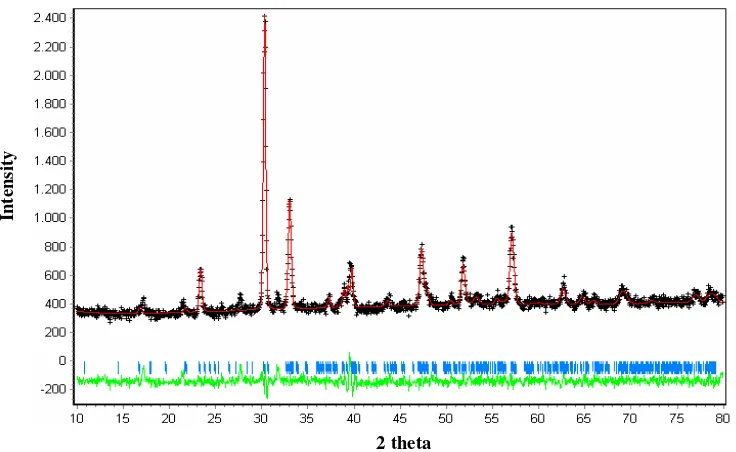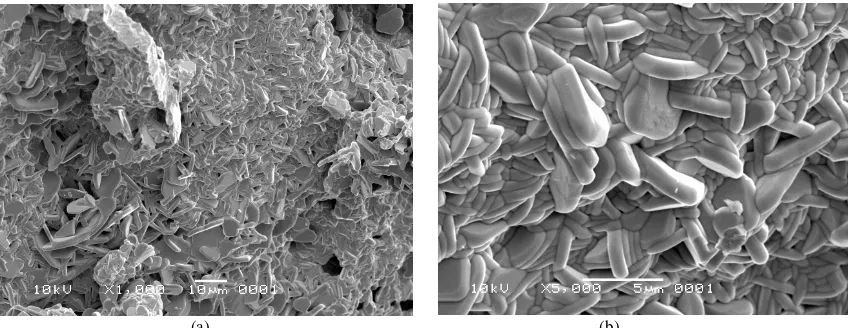T. Priyambodo et al. Proceeding of The International Seminar on Chemistry 2008 (pp. 469-472) Jatinangor, 30-31 October 2008
469
BaBi
4Ti
4O
15: Synthesis and characterization
Teguh Priyambodo, Iwan Hastiawan, Atiek Rostika Noviyanti*
Department of Chemistry, Faculty of Mathematics and Natural Sciences, Universitas Padjadjaran Jl. Raya Bandung–Sumedang Km.21. Jatinangor 45363. Indonesia
*e-mail: [email protected]
Abstract
Aurivillius oxide BaBi4Ti4O15 (BBT) has been used in the applied nanomaterials technology. The
ferroelectric materials properties expected to alternative solutions for computer memories, makes ferroelectric nonvolatile memories very attractive. The aim of this research is to determine structure and surface morphology of BaBi4Ti4O15 synthesis. The solid state reaction
method is used in this research. In the solid state reaction the temperature of 800 to 1100 oC is
applied for 24 hours. X-ray diffraction powder and SEM-EDAX ((Scanning Electron Microscope-Energy Dispersive Analysis of X-rays) are also used to determine the crystal structure. The results are in excellent agreement with the data that reported in PDF (Powder Diffraction File) Number 84-1750 (orthorhombic). The surface analysis of BaBi4Ti4O15 showed that the crystals are polycrystalline
with the size of 219.967 Å. Qualitative analyses using EDAX showed that Ba:Bi ratio in the crystal is 1:4.
Keywords: BBT, solid state reaction, aurivillius, orthorhombic, polycrystalline
Introduction
Ferroelectric materials have innumerable properties related to their spontaneous polarization, for instance, pyro and piezoelectricity, which are used for various sensors and actuators. The use of ferroelectric thin films brings not only the additional advantage of reduced weight and size, but it allows the fabrication of integrated devices which involve switching of the polarization between the two thermodynamically stable states. The development of sophisticated film-synthesis methods providing high-quality films, together with presently existing efforts to find new or alternative solutions for computer memories, makes ferroelectric nonvolatile memories very attractive. Simple perovskite ferroelectric films (such as PZT) on platinized silicon substrates exhibit high polarization fatigue. This problem could be overcome to some extent by replacing the Pt electrodes with conducting oxide electrodes or by replacing PZT with Bi based layer-structured ferroelectric oxides, which are known to be free of polarization fatigue up to 1012 cycles of polarization. These Bi-based layer-structured ferroelectric oxides belong to the Aurivillius family and can be described by the general formula (Bi2O2)++(An-1BnO3n+1)-- (Satyalakshmi
et al., 1998).
One interesting feature of the Aurivillius phases resides in the compositional flexibility of the perovskite blocks which allows to incorporate various cations such as Na+, K+, Ca2+, Sr2+, Ba2+, Pb2+, Bi3+ or Ln3+ for the A-site and Fe3+, Cr3+, Ti4+, Nb5+ or W6+ for the B-site. It is thus possible to modify the ferroelectric properties according to the chemical
composition. As an illustration, the majority of the Aurivillius oxides where A=Ba have a relax or type ferroelectric behavior to the difference of their analogues where A=Sr, Ca and Pb. Although this phenomenon was observed since many years, its structural origin is not yet clearly elucidated.
There is a considerable interest in replacing the current generation of thin film ferroelectrics, based on the perovskite (PZT), both from an environmental view and to improve performance. These Aurivillius oxides do not contain any of the toxic heavy metal, lead, and they also display superior fatigue-free behavior and lower coercive fields compared to PZT (Kennedy et al., 2003).
Very little is known about the information structure of the n=4 oxide. In the present work, we have determined the structure of the BBT. We had also to find out information about surface morphology of BBT.
Materials and Methods
T. Priyambodo et al. Proceeding of The International Seminar on Chemistry 2008 (pp. 469-472) Jatinangor, 30-31 October 2008
470
Results and Discussion
Preliminary X-ray diffraction data, recorded using Cu K radiation did not show any evidence of impurity phases. The observed pattern was in excellent agreement with that reported for orthorombic BaBi4Ti4O15. Structural parameters (Table 1) were refined by the Le Bail method with the program Rietica.
Table 1 Pameter of BBT cell refinment with Le Bail
method.
Crystal structure
A21am (orthorombic at room temperature)
BBT Cell
parameters PDF Data base
Le Baile calculated method
A (Å) b (Å) c (Å)
5.4309 5.4554 49.4921
5.4331(1) 5.4565(1) 49.5031(1)
Rp 4.35 4.39
Rwp 5.32 6.07
The difractogram from observation was compared with difractogran from PDF (Powder Diffraction File) software. The difractogram produce similiar peaks to PDF Number 35-0757 .
Plot the observed and calculated data was showed in Figure 1.
Particel size from BBT is 219.967 Å calculated with Scherrer equation:
θ β
λ
cos 92 , 0 =
t
With, t = crystal size = wave length
= peak width-full width at half maximum = diffraction angle.
The surface analysis of BaBi4Ti4O15 using SEM (Scanning Electron Microscope) and qualitative analyses of composition element using EDAX (energy-dispersive analysis of X-rays).
Figure 1 The Le Bail refinement plot showing the observed (+), calculated (red line), and their difference for
BBT. This plot showed in space group A21am at room temperature.
In
te
n
si
ty
T. Priyambodo et al. Proceeding of The International Seminar on Chemistry 2008 (pp. 469-472) Jatinangor, 30-31 October 2008
471
(a) (b)
Figure 2 BBT with dilation, (a) 1000 x and (b) 5000x
Table 2 Comparation of composition using EDAX
Element Massa (%) Uncertainty (%) Ar (gram/mol) Mol comparation Empiris formula
Ba 8.52 1.72 137.34 0.0820 1
Bi 68.85 0.78 208.98 0.3295 4
The SEM-EDAX is used to find information about surface morphology and element composition of BBT crystal. The morphology of BBT are non homogenous. The non homogenous crystal is predicted as a result of in complete reaction due to grinding. The crystal is predicted to be polycrystalline in Figure 2. Qualitative analyses using EDAX showed that Ba:Bi ratio in the crystal is 1:4 (Table 2).
Conclusions
The results are in excellent agreement with the data that reported in PDF (Powder Diffraction File) data base No. 84-1750 (orthorhombic). Particel size from BBT is calculated with Scherrer equation with the size of 219.967 Å. The surface analysis of BaBi4Ti4O15 using SEM showed that the crystals are polycrystalline. Qualitative analyses using EDAX showed that Ba:Bi ratio in the crystal is 1:4.
Acknowledgements
This work partially supported by Hibah Bersaing and Student Creativity Project of DIKTI 2008. We thank the Research Centre of Geology and Naval for the XRD and SEM-EDAX measurements. We would like to thanks Prof. Muljadji Agma and Dr. Diana Rakhmawaty Eddy for beneficial discussion.
References
Bath, F. 2005. Consistent Miling on A Nano Scale.
Ceramic Industry: Academic Research Library.
155, 26-29.
Boulle, A., Legrand, C., Guinebretiere, R., Mercurio, J. P and A. Dauger. 2001. X-Ray Diffraction Line Broadening by Stacking Faults in SrBi2Nb2O9/SrTiO3 expitaxial Thin Films. Thin Solid Films. 391, 42-46.
Cady, W.G. 1964. Piezoelectricity. Dower Book Pub.
New York.
Dunlap, R. A., Small, D. A., MacKay, G. R and and J. W. O. Brien. 2000. Materials Preparation by Ball Milling. Canadian Journal of Physics. 78,
211-229.
Haluska, M. S., Spekman, S and S. T. Misture. 2003. Crystal Structure Determinations of Three-Layer Aurivillius Ceramics Using A New Parallel Beam X-Ray Powder Diffractometer. International Centre for Diffraction Data 2003, Advance in X-ray Analysis. 46, 192-197.
Janssens and Grieken V. 2004. Comprehensive Analytical Chemistry XLII. Elsavier B. V.
Amsterdam.
Kawamoto, M., Kimura, M., Ando, A and Y. Sakabe. 2003. Synthesis of Bismuth Layer-Structured Ferroelectric Particles by Hydrotermal Method and The Fabrication of Oriented Ceramics.
Journal of The Ceramic Society of Japan. 112
T. Priyambodo et al. Proceeding of The International Seminar on Chemistry 2008 (pp. 469-472) Jatinangor, 30-31 October 2008
472 Kennedy, B.J., Kubota, Y., Hunter, B.A., Ismunandar
and Kato. 2003. Structural phase transition in the layered bismuth oxide BaBi4Ti4O15. Solid State Com. 126, 653
Knauth, P and J. Schoonman. 2004. Nanostuctured Materials: Selected Synthesis Methods, Properties and Applications. Kluwer Academic
Publisher. New York.
Kong, L. B., Zhang, T.S., Ma, J and F. Boey. 2007. Progress in Synthesis of Ferroelctric Ceramic Materials via High-Energy Mechanochemical Technique. Progress in Materials Science. In
Press.
Mikrianto, E dan Ismunandar. 2004. Sintesis dan Karakterisasi Senyawa Berstruktur Aurivillius Empat dan Lima Lapis dan Penentuan Sifat Feroelektriknya. Jurnal Matematika dan Sains. 9,
279-284.
Muller, R. S., R.P. Ried., E.S. Kim and D.M. Hong. 1993. Piezoelectric Microphone With On-Chip CMOS Circuits. Jounal Microelectomechanical System. 2, 111-120.
Nugroho, A dan K. Rosika. 2005. Aplikasi XRF untuk Analisa Unsur dalam Bahan. PUSPITEK. Tanggerang.
Roop, R. C. 2003. Solid State Chemistry. Elsevier
Science B. V. Amsterdam.
Satyalakshmi, K. M., Alexe, M., Pignolet, A., Zakharov, N. D., Harnagea, C., Senz., S and D. Hesse. 1999. BaBi4Ti4O15 Ferroelectric Thin Film Grown by Pulsed Laser Deosition. Applied Physics Letters.74, 603-605.
Settle, F.A. 1997. Handbook of Instrumental Techniques for Analytical Chemistry. Prentice
Hall-Inc. New Jersey.
Skoog, D .A., Holler,F.J and Nieman, A. T. 1998.
Principle of Instrumental Analysis. Fifth Edition.
Harcourt Brace & Company. New York.
Tellier, J., Boullay, Ph., Manier, M and D. Mercurio. 2004. A Comperative Study of The Aurivillius Phase Ferroelectrics CaBi4Ti4O15 and BaBi4Ti4O15. Journal of Solid State Chemistry,
177, 1829-1837.

